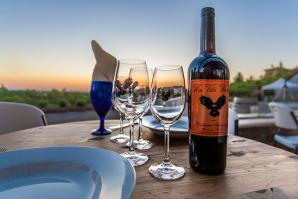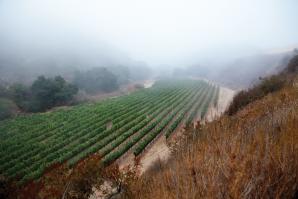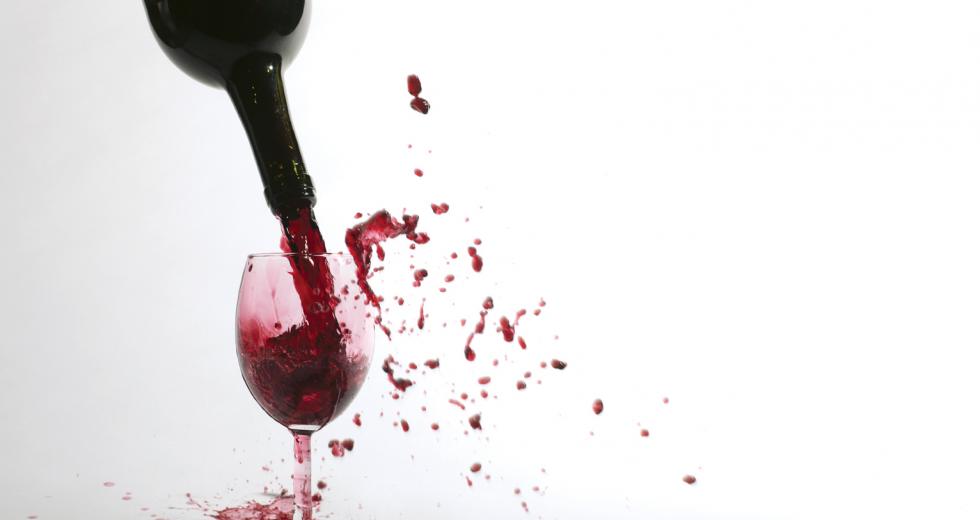Let’s say you’re in a glitzy Beijing restaurant. Your waiter uncorks a $300 bottle of Cabernet Sauvignon. He pours you a glass and you sip it, savor it, let it breathe. But around the table, everyone else gulps theirs down one swallow, like a shot, yelling “Gan bei!”
Welcome to wine culture in China.
It’s a nation with a billion potential wine drinkers, but it’s also a nation that has not, historically, cared much about wine. Domestic wine is often made with rice. The quality can be so grisly that it’s cut with orange juice or Sprite to wash it down.
This is changing. China is buying more watches, more homes, more cars. Wine seems inevitable. Thanks to a rising middle class, evolving tastes, and Hong Kong’s 2008 decision to cut import fees, China has grown into one of the world’s thirstiest markets for imported wine. That’s good news for producers in the Capital Region. In a bizarro reversal of manifest destiny, California wineries are racing to chase the upside, with export revenue jumping from $2.4 million in 2002 to $76 million last year. China is now California wine’s fifth largest destination.
“I saw China as the long-term play,” says Dennis Barnett, president of L2S Wine Partners International, a firm that joined with Sonoma Wine Co. to export wine to China. “In 2009, with the economy softening, everywhere else looked like a down market.” So he traveled to Beijing to conduct focus groups, study taste patterns and create a China-friendly label.
Barnett soon learned that U.S.-friendly packaging — bright, bold, splashy colors — would miss the mark in China. “You’ve heard of feng shui, right? I really didn’t know what the heck that meant, in a practical sense, until we went through this process. They were telling us balance, balance, balance. Tannins, acids, sugar; everything needed to be precise. And the packaging had to be balanced with the wine.”
Ninety percent of the wine consumed in China is red, partly because of the color’s cultural significance (the red flag, Communist imagery, the red envelope of good fortune). The average drinker is young (20 to 39), affluent and seeking to stay ahead of the aesthetic curve. Booming Chinese tourism has exposed more of the mainland to western wine culture, and when they return home, they proselytize. Barnett predicts 200 million wine consumers in China by the year 2020, compared to just 70 million in the U.S that year.
There’s just one tiny catch.
California wineries face a branding problem: They have no brand. “There’s a lack of awareness about California wines,” says Linsey Gallagher, director of international marketing for The Wine Institute. “They know about California — whether it’s Governor Schwarzenegger, the Golden Gate Bridge or Baywatch — we can thank our entertainment industry for that. But the lion’s share of consumers have no idea that California makes wine.”
So what, then, is the branding strategy? The answer for many industries is simple: customization. On a recent trip to Beijing, for example, I was shocked by the dominance of Kentucky Fried Chicken. I peeked inside a restaurant, curious, and discovered that KFC menus look nothing like our familiar buckets of fried cholesterol; instead, they offer a variety of noodle dishes. Or take Starbucks, whose 570 stores (and counting) offer treats like moon cakes and iced rice dumplings.
But wine is not chicken, and California wineries are betting that instead of changing their wine to fit China, they can educate China about California wine. The goal is to debunk misconceptions. Especially the misconceptions about France, which dominates the import market (followed by Australia, New Zealand, Italy and Chile. California is still the new kid in town.)
“There’s a widespread perception that French wine is superior, thanks in large part to France’s long-term strategic efforts,” says Frank Gayaldo, the president of Lodi-based Gayaldo International, a firm that specializes in exporting California wine. France has a 20-year head start, but Gayaldo says, “Blind taste tests throughout China consistently give California wines the decisive edge. But that means Chinese consumers have to taste it before they buy it.”
Barnett learned the same thing. He carved his focus groups into three camps: explorers (casual wine drinkers), discerners (such as people in wine clubs — a rare but growing niche) and professionals (sommeliers and collectors). The Chinese most familiar with premier wines had palettes that, generally, were trained to associate fine wine with flavors that were heavier and slower, like a French Bordeaux. The numbers back this up — China is the world’s largest importer of Bordeaux.
“We basically had to explain that it’s OK for a wine to be more accessible,” Barnett says. “California is about immediate gratification. Girls in bikinis, fast cars, cool clothes. You don’t have to wait three hours for the wine to open up. California wine is made to drink right now. It took a bit for them to relax, but once they did, they liked it.”
The primary strategy, therefore, is to get the message out. That’s where the Wine Institute comes in. Their sprawling marketing campaign, “Discover California Wines,” uses mediums like billboards, bus-wraps and subway light-boxes to connect pre-existing images of California (surf boards, beaches) with Napa and Sonoma vineyards. Every year they send a delegation of California winemakers to China to educate and mingle. They fly Chinese investors to California. They invite Chinese lifestyle writers to tastings, they conduct seminars and they explain the concept of pairing wine to food. Red with steak, white with scallops — obvious to us, foreign to much of China.
The challenges don’t stop at branding. Operations and distribution can be a nightmare. “We’ve had instances where one week a certain wine gets through customs, and then the next week, the exact same wine doesn’t,” Gallagher says. Infrastructure is improving but still problematic, so once your bottle of Sonoma Pinot Grigio clears customs, it might travel through the bumpy streets of Beijing on a rickshaw.
Payments can be slow, there’s enough red tape to choke on and it’s tough to find a reliable importer. “Everyone and their brother is trying to become a wine importer in China, so their longevity is often six months or less. Some of these are fly by night,” Gallagher says. Counterfeiting is rampant — just like fake Apple shops, there are fake bottles of Gallo. And the issue packs a double-whammy: Every fake bottle of Rivercrest is one less bottle sold by Gallo, and since the quality is poor, that builds mistrust amongst the end consumer who is then less likely to buy the real McCoy.
The communist government is a wild card, negotiations can be tricky and even those fluent in Mandarin can find themselves swallowed in misunderstandings. “Cultural differences can result in a deal hitting a brick wall, with both sides leaving the table frustrated,” says Gayaldo. “On top of that, there are significant regional differences throughout China, just like we have here at home. Try conducting business in Galt the same way you would in New York City.”
The key takeaway? Patience. The forces at play — education, tourism, a growing middle class — are shifting tectonic plates, not an Internet wunderkind. Yes, there’s gold in them hills, but get ready for meetings, more meetings and then more meetings. Gallagher says the rule of thumb is to not expect dividends for three to five years. “I am very optimistic about China overall,” she says, pausing. “But you’re not going to do it in one trip.”
There’s one final wrinkle. Taking an even longer view, it’s not a stretch to think that China could, eventually, emerge as a leader in wine production. China grows 10 percent of the world’s grapes. They have plenty of land. And they’re already enticing experts to plunk down wineries on the mainland; local Chinese businessmen are working with Domaines Barons de Rothschild, a celebrated French winemaker, to open a 4.3-acre winery in Shandong. Chinese winemakers are traveling abroad to learn new techniques. This echoes the early-1980s policy of Deng Xiaoping (Chairman Mao’s successor), who encouraged doctors, engineers and scientists to travel abroad, soak up western knowledge and then return to China to sow the seeds of progress. The strategy worked. Why not with wine?
Thankfully, no amount of technology (short of Skynet) can replicate Schwarzenegger, the Golden Gate Bridge or the magic of Sonoma. California wineries have pole position. The race is on.
Jeff Wilser is the author of “The Maxims of Manhood.” His work has appeared in print or online in GQ, Esquire, Glamour, mental_floss, and VH1. On Twitter at
@jeffwilser.
Recommended For You

Wine Winner
How Dr. Grover Lee went from the pharmacy to the vineyard
Imagine you’re a successful businessman, but what you really want to be is a professional baseball player. You’re so sure of yourself that you begin spending nights and weekends studying and training as if Major League Baseball will soon be calling. And then they actually do, and at your first at-bat, you clear the bases.
That’s pretty much how things happened when Granite Bay pharmacist Dr. Grover Lee decided to become an award-winning winemaker.

Message in a Bottle
Monterey’s wine country scores with a new marketing strategy
On a late afternoon in the Caraccioli Cellars tasting room, the scrape of bar stools on the concrete floor signals the arrival of yet another couple exploring Monterey’s thriving wine scene.



